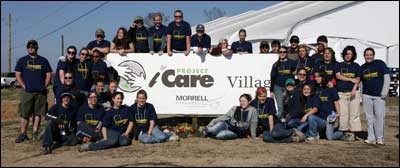The 37 students who participated in NAU’s first Alternative Spring Break last week were well-prepared for the physical labor they anticipated in helping a Gulf Coast community rebuild after being ravaged by Hurricane Katrina. What they hadn’t predicted, however, was how the experience would change their lives.
When they arrived in Hancock County, Miss., after a 30-hour bus ride, the students sat in silence as the reality of the situation hit.
|
“We had just driven through complete devastation,” said Kristin Morrison, a junior visual communications major. “I had not expected to find Waveland completely wiped out.”
They saw homes that had been lifted completely off their foundations with all the belongings still inside, and others that had been entirely flattened to piles of rubble. There was debris and trash everywhere and most everything was covered in thick mud or black mold.
Most agreed that what they had seen on TV couldn’t compare to seeing the destruction firsthand.
“Every worldly possession these people had is gone,” Morrison said.
Community Collaborations, the agency that helped NAU organize the trip, intermingled the group with about 100 students from three other schools to tackle a variety of gruesome and physically demanding restoration projects throughout the community, including home demolition, sheet rocking, carpentry, roofing, trash collection and more.
“We gutted a house that hadn’t been touched since the storm—mud and black mold was everywhere,” Morrison said. “I picked up a dead rat, not realizing what it was. Everything was just that dirty and gross. Then it just hit me that there’s that much damage, that even the smallest animal couldn’t survive this.”
While all the students worked hard, agency representatives expressed a special affinity for the NAU students.
“When we left they said they never had a group that showed as much initiative as ours,” Morrison said. “We just jumped in to help out in the kitchen or grabbed trash bags to take down to the beach to clean up there. We were constantly keeping busy doing things without being asked. They loved the Arizona kids.”
The group of four schools provided about 12,000 work hours, saving Waveland residents more than $240,000 in contracting expenses.
For Morrison, the trip was more than worthwhile; it was necessary. “They need help,” she said. “The community called us the cavalry after the storm.”
But with an estimated six to eight years before the town will be rebuilt, there is still much work to be done. Many students are already planning to return this summer to continue with the clean up effort.
“This was a humbling, selfless experience that has taught me something about the importance of the universal man,” Morrison said. “If one person suffers we all suffer. If one person needs help, humanity should be there to provide it.”
To see how one student documented the trip through her photography, click here.



